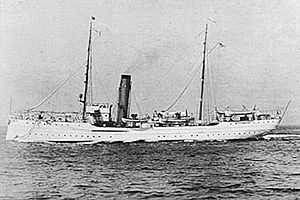USRC Mohawk (1904)
 | |
| Career (United States) | |
|---|---|
| Name: | USS Mohawk |
| Namesake: | The Mohawk Native American tribe |
| Builder: |
William R. Trigg Company, Richmond, Virginia[1] |
| Commissioned: | 10 May 1904 into United States Revenue Cutter Service |
| Recommissioned: | 6 April 1917 by United States Navy |
| Fate: |
Sunk in collision near Sandy Hook, New Jersey 1 October 1917 |
| General characteristics | |
| Displacement: | 1,150 tons |
| Length: | 205 ft 6 in (62.64 m) |
| Beam: | 32 ft 0 in (9.75 m) |
| Draft: | 12 ft 7 in (3.84 m) |
| Armament: | 4 x 6 pounder (1915) |
USRC Mohawk, was a steel steam powered revenue cutter built for the U.S. Revenue Cutter Service by William R. Trigg Company at Richmond, Virginia. She was commissioned into the United States Revenue Cutter Service on 10 May 1904.[1] Based at New York, New York, she cruised the Atlantic Ocean and adjacent waters between Gay Head, Massachusetts, and the Delaware breakwater. When the Revenue Cutter Service merged with the United States Lifesaving Service to form the United States Coast Guard in 1915, she became a Coast Guard cutter. Her primary duties in the Revenue Cutter Service and Coast Guard were assisting vessels in distress and enforcing navigational laws as well as a derelict destroyer.[1]
Mohawk was temporarily transferred to the United States Navy on 6 April 1917 for service in World War I. She was the fourth ship known by that name commissioned into the Navy. While serving on coastal duty in connection with convoy operations, she was struck by the British tanker SS Vennacher and sank on 1 October 1917 off Sandy Hook, New Jersey. All hands were saved but the water was deemed too deep to warrant salvage operations.
Notes
- Citations
- References
- This article incorporates text from the public domain Dictionary of American Naval Fighting Ships.
- Canney, Donald L. (1995). U.S. Coast Guard and Revenue Cutters, 1790–1935. Naval Institute Press, Annapolis, Maryland. ISBN 978-1-55750-101-1.
External links
- Photo gallery at navsource.org